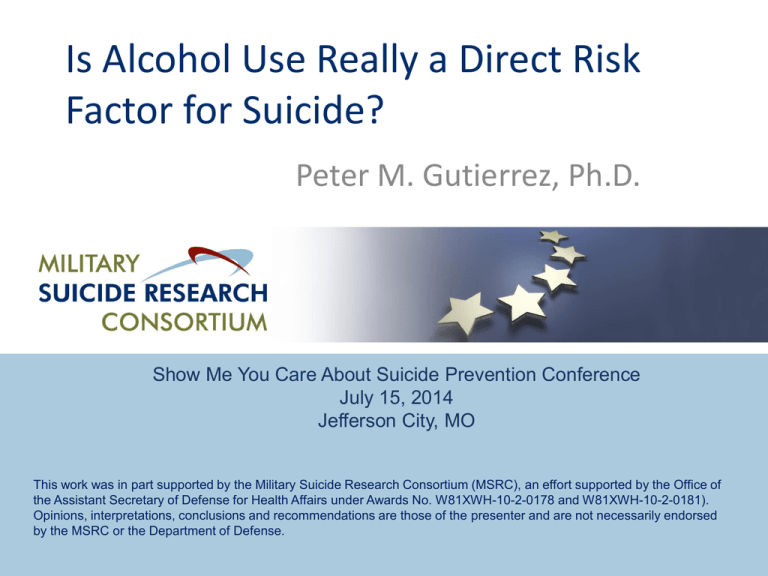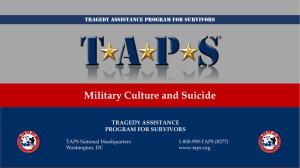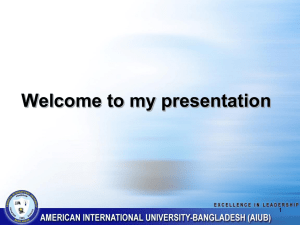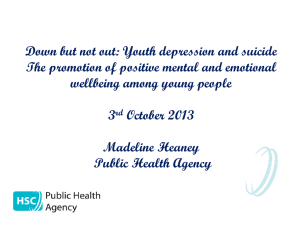
Is Alcohol Use Really a Direct Risk
Factor for Suicide?
Peter M. Gutierrez, Ph.D.
Show Me You Care About Suicide Prevention Conference
July 15, 2014
Jefferson City, MO
This work was in part supported by the Military Suicide Research Consortium (MSRC), an effort supported by the Office of
the Assistant Secretary of Defense for Health Affairs under Awards No. W81XWH-10-2-0178 and W81XWH-10-2-0181).
Opinions, interpretations, conclusions and recommendations are those of the presenter and are not necessarily endorsed
by the MSRC or the Department of Defense.
Thanks to my Collaborators
Michael Anestis, Ph.D.
Thomas Joiner, Ph.D.
Jetta E. Hanson, M.A.
“... many widely held beliefs … are
never exposed to the possibility of
criticism, with the result that language
transmits not only wisdom but also a
type of folly that is difficult to
eradicate.”
F.A. Hayek (1988), The Fatal Conceit, p. 106.
Many people who die by suicide
are intoxicated at the time of death
o “Alcohol use is strongly related to impulsive suicide
attempts” (Weiss & Hufford, 1999, p. 301)
o “Alcohol, through its disinhibiting effects is related
to suicide attempts and completions” (IOM, 2002, p.
81)
o “For some, it is a daring recreational maneuver that
goes a little too far, often in the setting of
drunkenness or a drug high.” (Welte et al., 1988)
Have you ever written something
like this in a patient’s medical
record?
Mr. X’s risk of suicide is greatest when he has
been drinking. Therefore, the key to avoiding a
future act of self-directed violence is to ensure
that he not become intoxicated.
Let’s examine some widely held
beliefs
Intoxication facilitates lethal selfharm by lowering inhibitions,
impairing judgment, and
decreasing coordination and fine
motor skill
Intoxicated individuals die as a
result of accidental weapons
discharges, misclassified as suicide
Intoxication facilitates “impulsive”
self-directed violence
What are the implications of
refuting a long held belief within
the suicidology community?
Why does it matter that many
suicide decedents likely were not
intoxicated at the point when they
engaged in lethal self-directed
violence?
What might the impact be on
treatment planning and disposition
decisions?
What do we really know about the
relationship between alcohol and
suicide?
Links between impulsivity and
lethality of attempts
o Inversely related (Baca-Garcia et al., 2001; Connor et al.,
2006; Nakagawa et al., 2009)
o Degree of planning and premeditation
positively related with lethality
o Those diagnosed with substance dependence
less likely to make impulsive attempts
Links between alcohol
consumption and suicide
o Swedish decedents had higher urine than
blood alcohol concentration (Ostrom et al., 1996)
o Blood increases after consumption, urine after
metabolization
o If alcohol = impulsive, then findings should be the other
way around
Fine, but you’ve only cited a few
studies, and most are fairly old
What is the current state of the
literature?
Comprehensive Review
o Multiple databases searched for combination
of “BAC”, “blood alcohol content”, and “suicide”
o Published in English, human subjects, %
decedents with blood alcohol levels, accounted
for % died by suicide
o 92 articles published from 1979 to 2012
o 167,894 cases available for analyses
Anestis, M. D., Joiner, T., Hanson, J. E., & Gutierrez,
P. M. (in press). The modal suicide decedent did not
consume alcohol just prior to the time of death: An
analysis with implications for understanding suicidal
behavior. Journal of Abnormal Psychology.
Variables Recorded
o Year published
o Number of decedents who died by suicide
o Method of suicide
o Gender
o Age
o Ethnicity
o Country
o Presence of alcohol
Decedent Characteristics
o Average of 1,825 per study
o Ranged from 6 to 57,813
o 75% male
o Mean age 42
Presence of Alcohol at Death
o Of all suicide decedents, 26.86% had positive blood
alcohol content
o Weighted by study sample size
o 15 studies of accidents (representing 27,975
decedents) reported 31.71% with positive blood
alcohol content
o 18 studies of homicide (representing 18,322
decedents) reported 37.72% with positive blood
alcohol content
Do demographics influence
results?
o Percentage sample male x percentage suicide
decedents with positive BAC (r = .05, p = .65)
o Likely due to predominantly male samples across studies
o Age x percentage suicide decedents with
positive BAC (r = -.17, p = .21)
No, and neither does publication
bias
o Year of publication x percentage suicide
decedents with positive BAC (r = .03, p = .80)
But race matters
o Significantly correlated with the percentage of
suicide decedents with positive BAC (r = -.54; p =
.001)
o Higher proportion of Caucasian decedents, lower
frequency of positive BAC
o Not able to parse this finding across samples, so must
conclude that multiple factors at play and no definitive
explanation at this time
Myth or Supported by Data?
Intoxication facilitates lethal selfharm
o Keep in mind that BAC is not the same as
intoxication
o And in at least one study urine levels were higher than
blood
o Maybe, for a small percentage of decedents,
but clearly not the norm
o Approximately 27% of almost 170,000 decedents had
measurable BAC at time of death
Intoxication facilitates “impulsive”
self-directed violence
o Predicated on belief that anyone impulsively
attempts suicide
o If this were true, many more decedents would
have positive BAC at the time of death
o Data would need to confirm that BAC
significantly higher than urine levels
(Anestis et al., in press)
Is it accurate to say the modal
suicide victim consumed alcohol
shortly before the time of death?
Then what can we say?
o Alcohol use problems elevate the risk of
suicide
o Consumption associated with 20% increase in next hour
ideation and 1/3 of attempters consumed alcohol in
previous 24 hours (Bagge et al., 2014)
o Proximity of consumption to attempt unknown
o People die when intoxicated
o Most people likely aren’t intoxicated, nor have
they consumed alcohol, prior to suicide
What are the risks for patients?
o Clinicians may be making crucial treatment
planning and disposition decisions based on
faulty assumptions
Unanswered Questions
o What percentage of suicide decedents meet
criteria for alcohol dependence?
o Positive BAC rates could be artificially inflated by those
who are more likely to be positive regardless of what they
are doing
o How do racial, ethnic, and cultural differences
influence the relationship between BAC and
suicide?
o How does BAC influence choice of method?
Research Implications
o Distinguish between + BAC and intoxication
by recording levels
o Fine grained comparisons by criterion of
intoxication
o Do some choose not to drink for fear of
interfering with attempt?
Clinical Implications
o Information about alcohol dependence
relevant to overall risk profile
o Likely not useful to think of as warning sign
o Underlying problems which lead to alcohol
misuse may also be drivers of suicide
o Treating those problems should also address suicide risk
o Don’t assume that staying sober will prevent
suicide
Clinical Implications
o Death by suicide is difficult
o Requires confronting high levels of
physiological and affective pain
o Alcohol consumption factors into the mix, but
unlikely to be the primary one for the
majority of those who die by suicide
Paradigm Shift
o Alcohol consumption is common in the U.S.
o Even more common in those with mental
disorders
o Reasonable to assume it would therefore be
quite common in suicide decedents
o Proximal risk factor activated by high stress
Paradigm Shift
o Results suggest one of many factors, proximal
for some, distal for others
o Suicide is difficult and requires planned and
deliberate pursuit of death
o Identify and treat those factors most likely to
contribute to desire and capability to engage
in lethal self-harm
(Joiner, 2005)
o Many potential mechanisms linking alcohol
consumption to suicide
o To date, none empirically tested
Conclusion
o Alcohol and suicide do mix, but maybe not in
the ways and to the extent many assume
o Adopting a different paradigm may lead to
more deaths being prevented
Thank You for Your Attention
Peter M. Gutierrez, Ph.D.
Co-Director
Military Suicide Research Consortium
www.msrc.fsu.edu










